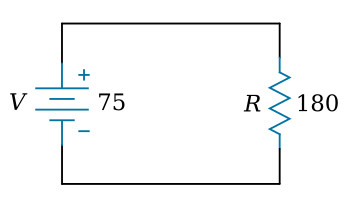Home > Textbooks > Basic Electronics > DC Circuits > Power >
DC Circuits
Power
Power is the rate at which work is being done. Work is performed when a force causes a mass to be displaced. A familiar example of work involves a weight. When a mechanical force is used to lift or move the weight, work is done. However, force exerted without causing motion, such as the force of a compressed spring acting between two fixed objects, does not constitute work.
Since energy is the ability to do work, power can also be defined as the time rate of developing or expending energy. Energy exists in several forms: chemical, mechanical, heat, light, and electric energy. There are also many devices that convert one form of energy to another. An important energy-converting device is the battery. A battery is a device that converts chemical energy to electric energy.
It was shown that voltage is an electrical force, and that voltage forces a mass (electrons) to flow in a closed circuit. However, when voltage exists but current does not flow because the circuit is open, no work is done. This is similar to the spring under tension that produced no motion. When voltage causes electrons to move, work is done. The instantaneous rate at which this work is done is called the electric power, and is measured in watts (W). Expressed as an equation, the relationship between power, work, and time is

where
P is power in watts
W is work in joules
t is time in seconds
A total amount of work may be done in different lengths of time. For example, a given number of electrons may be moved from one point to another in 1 second or in 1 hour, depending on the rate at which they are moved. In both cases, total work done is the same. However, when the work is done in a short time, the wattage, or instantaneous power, is greater than when the same amount of work is done over a longer period of time (see the previous equation).
As stated, the basic unit of power is the watt. Power in watts is equal to the voltage across a circuit multiplied by current through the circuit. This represents the rate at any given instant at which work is being done. The symbol P indicates electric power. Thus, the basic power formula is
![]()
where V is voltage and I is current in the circuit.
By substituting Ohm's law into the basic power formula P = V × I, other equations can be derived that are useful in determining power:

The resultant equation is useful when the resistance and voltage are known.
The power formula can also be expressed as an equation in terms of current and resistance.

It can be seen from the preceding that current flowing through a resistance causes energy to be transformed. In this case electric energy is transformed to heat energy. The rate at which energy is transformed is power. Many electric components are given power ratings, which indicate the rates at which they can dissipate heat energy without being destroyed.
Example:
In the circuit of figure below, find the power dissipated
as heat in the resistor.

Solution:
To find the power dissipated in the resistor, the equation P=V2/R is applied

It should be noted that all the power supplied by the battery is dissipated in the form of heat by the resistor.






